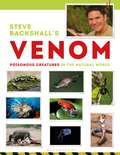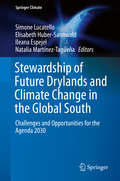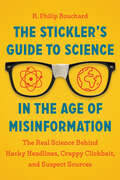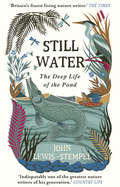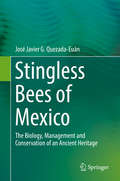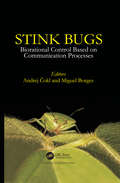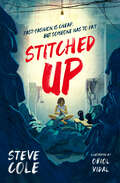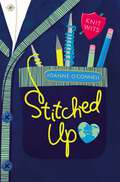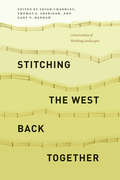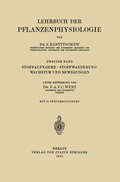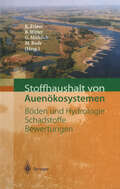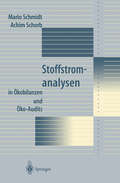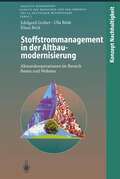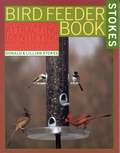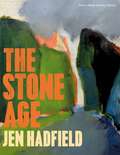- Table View
- List View
Steve Backshall's Venom
by Steve BackshallTV presenter Steve Backshall needs no introduction following his performances on TV series such as Deadly 60 and Lost Land of … This is a reformatted, redesigned edition of a popular title. Poison is an everyday part of the animal world, and an essential tool for hunting and defence. A wide variety of insects, reptiles and amphibians use toxins to subdue their prey or to stop becoming prey to another predator. Even some mammals and birds resort to poison as a means of securing a meal or deterring attack!From species such as the King Cobra, Lionfish, Fat-tail Scorpion and Poison Dart-frog to the diminutive but lethal Black Widow Spider, the author takes a fascinating look at the different types of natural venoms. On a tour of the world's continents, he looks at over 60 of the most venomous creatures, describing their main characteristics and explaining how they administer their venom and what its effects are. Stunning colour photographs and exciting accounts of Steve's own encounters with some of these animals bring the world of natural venom alive.
Stewardship of Future Drylands and Climate Change in the Global South: Challenges and Opportunities for the Agenda 2030 (Springer Climate)
by Simone Lucatello Elisabeth Huber-Sannwald Ileana Espejel Natalia Martínez-TagüeñaThis volume integrates a conceptual framework with participatory methodologies to understand the complexities of dryland socio-ecological systems, and to address challenges and opportunities for stewardship of future drylands and climate change in the global south. Through several case studies, the book offers a transdisciplinary and participatory approach to understand the complexity of socio-ecological systems, to co-produce accurate resource management plans for sustained stewardship, and to drive social learning and polycentric governance. This systemic framework permits the study of human-nature interrelationships through time and in particular contexts, with a focus on achieving progress in accordance with the 2030 United Nations Agenda for Sustainable Development. The book is divided into four main sections: 1) drylands and socio-ecological systems, 2) transdisciplinarity in drylands, 3) interculturality in drylands, and 4) the governance of drylands. Expert contributors address topics such as pastoralism and the characteristics of successful agricultural lands, the sustainable development goals and drylands, dryland modernization, and arid land governance with a focus on Mexico. The volume will be of interest to dryland researchers, sustainable development practitioners and policymakers.
The Stickler's Guide to Science in the Age of Misinformation: The Real Science Behind Hacky Headlines, Crappy Clickbait, and Suspect Sources
by R. Philip BouchardA wise and witty look at the real scientific principles behind some of the most commonly held—and widely spread—scientific misconceptions.
Still Alive: A Wild Life of Rediscovery
by Forrest GalanteThrilling adventures in wildlife conservation from &“the Indiana Jones of Biology&” (Entrepreneur)Very few individuals can truthfully say that their work impacts every person on earth. Forrest Galante is one of them. As a wildlife biologist and conservationist, Galante devotes his life to studying, rediscovering, and protecting our planet&’s amazing lifeforms. Part memoir, part biological adventure, Still Alive celebrates the beauty and determined resiliency of our world, as well as the brave conservationists fighting to save it. In his debut book, Galante takes readers on an exhilarating journey to the most remote and dangerous corners of the world. He recounts miraculous rediscoveries of species that were thought to be extinct and invites readers into his wild life: from his upbringing amidst civil unrest in Zimbabwe to his many globetrotting adventures, including suspenseful run-ins with drug cartels, witch doctors, and vengeful government officials. He shares all of the life-threatening bites, fights, falls, and jungle illnesses. He also investigates the connection between wildlife mistreatment and human safety, particularly in relation to COVID-19. Still Alive is much more than just a can&’t-put-down adventure story bursting with man-eating crocodiles, long-forgotten species rediscovered, and near-death experiences. It is an impassioned, informative, and undeniably inspiring examination of the importance of wildlife conservation today and how every individual can make a difference.
Still Water: The Deep Life of the Pond
by John Lewis-StempelThe Pond. Nothing in the countryside is more humble or more valuable. It’s the moorhen’s reedy home, the frog’s ancient breeding place, the kill zone of the beautiful dragonfly. More than a hundred rare and threatened fauna and flora depend on it. Written in gorgeous prose, Still Water tells the seasonal story of the wild animals and plants that live in and around the pond, from the mayfly larvae in the mud to the patrolling bats in the night sky above. It reflects an era before the water was polluted with chemicals and the land built on for housing, a time when ponds shone everywhere like eyes in the land, sustaining life for all, from fish to carthorse. Still Water is a loving biography of the pond, and an alarm call on behalf of this precious but overlooked habitat. Above all, John Lewis-Stempel takes us on a remarkable journey – deep, deep down into the nature of still water.
A Sting in the Tale: My Adventures With Bumblebees
by Dave GoulsonA Sunday Times bestsellerShortlisted for the 2013 Samuel Johnson PrizeDave Goulson has always been obsessed with wildlife, from his childhood menagerie of exotic pets and dabbling in experimental taxidermy to his groundbreaking research into the mysterious ways of the bumblebee and his mission to protect our rarest bees.Once commonly found in the marshes of Kent, the short-haired bumblebee is now extinct in the UK, but still exists in the wilds of New Zealand, descended from a few queen bees shipped over in the nineteenth century. A Sting in the Tale tells the story of Goulson’s passionate drive to reintroduce it to its native land and contains groundbreaking research into these curious creatures, history’s relationship with the bumblebee, the disastrous effects intensive farming has had on our bee populations and the potential dangers if we are to continue down this path.
Stingless Bees of Mexico: The Biology, Management and Conservation of an Ancient Heritage
by José Javier Quezada-EuánThe stingless bees are the most diverse group of highly social bees and are key species in our planet’s tropical and subtropical regions, where they thrive. In Mexico, the management of stingless bees dates back centuries, and they were an essential part of the culture and cosmogony of native peoples like the Maya. In recent decades a vast amount of information has been gathered on stingless bees worldwide. This book summarizes various aspects of the biology and management of stingless bees, with special emphasis on the Mexican species and the traditions behind their cultivation. Much of the information presented here was produced by the author and the team of researchers at the Universidad Autónoma de Yucatán in the course of three decades of working with these insects. Given the breadth of its coverage, the book offers an equally valuable reference guide for academics, students and beekeepers alike.
Stinkbugs: Biorational Control Based on Communication Processes
by Andrej Cokl Miguel BorgesThis book presents an overview of the Pentatomidae species, covering their biology, phylogeny and reproductive behavior, main plants used in their diet and their nutritional exigencies, predatory stinkbugs, interactions between herbivores-plants and natural enemies, use of pheromone for monitoring phytophagous populations, and chemical and vibrational communication signals. It also presents possible technologies to be applied in field crops for pest management that could be developed as the basis of the interplay of stink bug communication signals.
Stinkbugs: Biorational Control Based on Communication Processes
by Andrej Čokl Miguel BorgesThis book presents an overview of the Pentatomidae species, covering their biology, phylogeny and reproductive behavior, main plants used in their diet and their nutritional exigencies, predatory stinkbugs, interactions between herbivores-plants and natural enemies, use of pheromone for monitoring phytophagous populations, and chemical and vibrational communication signals. It also presents possible technologies to be applied in field crops for pest management that could be developed as the basis of the interplay of stink bug communication signals.
Stitched Up
by Steve ColeTricked into working in an illegal garment factory in Hanoi, Hanh's life has become a daily hell. She is desperate to escape – but it's a path fraught with danger … The horrific real-life cost of fast fashion is exposed in this gripping tale of survival from bestselling author Steve Cole.
Stitched Up
by Joanne O'ConnellStitched Up is the heartwarming and fashion-forward novel from author and journalist Jo O'Connell, perfect for Elle McNicoll and younger fans of Geek Girl.Cassie has always had a passion for fashion — she loves finding quirky vintage looks from history. But when she starts Silverdale High School and becomes fast friends with label-obsessed Azra, she quickly realizes that to fit in, she'll have to worry about what people are wearing now, not in Tudor England. So when she, Az and eco-warrior Fern are drafted to redesign the school uniform, Cassie's caught between her real love of fashion and keeping up appearances.When Cassie's neighbour introduces her to The Knitwits, a local knitting group who are coming apart at the seams, Cassie finally starts to feel like she can be herself with people who accept her as she is and whips them into shape to take their designs to the next level.But with the design competition at school heating up, Cassie soon finds herself living two lives and Azra is starting to ask questions.Can she keep her new love a secret when she wants to shout about it from the rooftops?
Stitching the West Back Together: Conservation of Working Landscapes (Summits: Environmental Science, Law, and Policy)
by Susan CharnleyNews headlines would often have us believe that conservationists are inevitably locked in conflict with the people who live and work on the lands they seek to protect. Not so. Across the western expanses of the United States, conservationists, ranchers, and forest workers are bucking preconceptions to establish common ground. As they join together to protect the wide open spaces, diverse habitats, and working landscapes upon which people, plants, and animals depend, a new vision of management is emerging in which the conservation of biodiversity, ecosystem integrity, and sustainable resource use are seen not as antithetical, but as compatible, even symbiotic goals. Featuring contributions from an impressive array of scientists, conservationists, scholars, ranchers, and foresters, Stitching the West Back Together explores that expanded, inclusive vision of environmentalism as it delves into the history and evolution of Western land use policy and of the working landscapes themselves. Chapters include detailed case studies of efforts to promote both environmental and economic sustainability, with lessons learned; descriptions of emerging institutional frameworks for conserving Western working landscapes; and implications for best practices and policies crucial to the future of the West’s working forests and rangelands. As economic and demographic forces threaten these lands with fragmentation and destruction, this book encourages a hopeful balance between production and conservation on the large, interconnected landscapes required for maintaining cultural and biological diversity over the longterm.
Stitching the West Back Together: Conservation of Working Landscapes (Summits: Environmental Science, Law, and Policy)
by Susan Charnley Thomas E. Sheridan Gary P. NabhanNews headlines would often have us believe that conservationists are inevitably locked in conflict with the people who live and work on the lands they seek to protect. Not so. Across the western expanses of the United States, conservationists, ranchers, and forest workers are bucking preconceptions to establish common ground. As they join together to protect the wide open spaces, diverse habitats, and working landscapes upon which people, plants, and animals depend, a new vision of management is emerging in which the conservation of biodiversity, ecosystem integrity, and sustainable resource use are seen not as antithetical, but as compatible, even symbiotic goals. Featuring contributions from an impressive array of scientists, conservationists, scholars, ranchers, and foresters, Stitching the West Back Together explores that expanded, inclusive vision of environmentalism as it delves into the history and evolution of Western land use policy and of the working landscapes themselves. Chapters include detailed case studies of efforts to promote both environmental and economic sustainability, with lessons learned; descriptions of emerging institutional frameworks for conserving Western working landscapes; and implications for best practices and policies crucial to the future of the West’s working forests and rangelands. As economic and demographic forces threaten these lands with fragmentation and destruction, this book encourages a hopeful balance between production and conservation on the large, interconnected landscapes required for maintaining cultural and biological diversity over the longterm.
Stitching the West Back Together: Conservation of Working Landscapes (Summits: Environmental Science, Law, and Policy)
by Susan Charnley Thomas E. Sheridan Gary Paul NabhanNews headlines would often have us believe that conservationists are inevitably locked in conflict with the people who live and work on the lands they seek to protect. Not so. Across the western expanses of the United States, conservationists, ranchers, and forest workers are bucking preconceptions to establish common ground. As they join together to protect the wide open spaces, diverse habitats, and working landscapes upon which people, plants, and animals depend, a new vision of management is emerging in which the conservation of biodiversity, ecosystem integrity, and sustainable resource use are seen not as antithetical, but as compatible, even symbiotic goals. Featuring contributions from an impressive array of scientists, conservationists, scholars, ranchers, and foresters, Stitching the West Back Together explores that expanded, inclusive vision of environmentalism as it delves into the history and evolution of Western land use policy and of the working landscapes themselves. Chapters include detailed case studies of efforts to promote both environmental and economic sustainability, with lessons learned; descriptions of emerging institutional frameworks for conserving Western working landscapes; and implications for best practices and policies crucial to the future of the West’s working forests and rangelands. As economic and demographic forces threaten these lands with fragmentation and destruction, this book encourages a hopeful balance between production and conservation on the large, interconnected landscapes required for maintaining cultural and biological diversity over the longterm.
Stitching the West Back Together: Conservation of Working Landscapes (Summits: Environmental Science, Law, and Policy)
by Susan Charnley, Thomas E. Sheridan, and Gary P. NabhanNews headlines would often have us believe that conservationists are inevitably locked in conflict with the people who live and work on the lands they seek to protect. Not so. Across the western expanses of the United States, conservationists, ranchers, and forest workers are bucking preconceptions to establish common ground. As they join together to protect the wide open spaces, diverse habitats, and working landscapes upon which people, plants, and animals depend, a new vision of management is emerging in which the conservation of biodiversity, ecosystem integrity, and sustainable resource use are seen not as antithetical, but as compatible, even symbiotic goals. Featuring contributions from an impressive array of scientists, conservationists, scholars, ranchers, and foresters, Stitching the West Back Together explores that expanded, inclusive vision of environmentalism as it delves into the history and evolution of Western land use policy and of the working landscapes themselves. Chapters include detailed case studies of efforts to promote both environmental and economic sustainability, with lessons learned; descriptions of emerging institutional frameworks for conserving Western working landscapes; and implications for best practices and policies crucial to the future of the West’s working forests and rangelands. As economic and demographic forces threaten these lands with fragmentation and destruction, this book encourages a hopeful balance between production and conservation on the large, interconnected landscapes required for maintaining cultural and biological diversity over the longterm.
Stitching the West Back Together: Conservation of Working Landscapes (Summits: Environmental Science, Law, and Policy)
by Susan Charnley, Thomas E. Sheridan, and Gary P. NabhanNews headlines would often have us believe that conservationists are inevitably locked in conflict with the people who live and work on the lands they seek to protect. Not so. Across the western expanses of the United States, conservationists, ranchers, and forest workers are bucking preconceptions to establish common ground. As they join together to protect the wide open spaces, diverse habitats, and working landscapes upon which people, plants, and animals depend, a new vision of management is emerging in which the conservation of biodiversity, ecosystem integrity, and sustainable resource use are seen not as antithetical, but as compatible, even symbiotic goals. Featuring contributions from an impressive array of scientists, conservationists, scholars, ranchers, and foresters, Stitching the West Back Together explores that expanded, inclusive vision of environmentalism as it delves into the history and evolution of Western land use policy and of the working landscapes themselves. Chapters include detailed case studies of efforts to promote both environmental and economic sustainability, with lessons learned; descriptions of emerging institutional frameworks for conserving Western working landscapes; and implications for best practices and policies crucial to the future of the West’s working forests and rangelands. As economic and demographic forces threaten these lands with fragmentation and destruction, this book encourages a hopeful balance between production and conservation on the large, interconnected landscapes required for maintaining cultural and biological diversity over the longterm.
Stitching the West Back Together: Conservation of Working Landscapes (Summits: Environmental Science, Law, and Policy)
by Susan Charnley, Thomas E. Sheridan, and Gary P. NabhanNews headlines would often have us believe that conservationists are inevitably locked in conflict with the people who live and work on the lands they seek to protect. Not so. Across the western expanses of the United States, conservationists, ranchers, and forest workers are bucking preconceptions to establish common ground. As they join together to protect the wide open spaces, diverse habitats, and working landscapes upon which people, plants, and animals depend, a new vision of management is emerging in which the conservation of biodiversity, ecosystem integrity, and sustainable resource use are seen not as antithetical, but as compatible, even symbiotic goals. Featuring contributions from an impressive array of scientists, conservationists, scholars, ranchers, and foresters, Stitching the West Back Together explores that expanded, inclusive vision of environmentalism as it delves into the history and evolution of Western land use policy and of the working landscapes themselves. Chapters include detailed case studies of efforts to promote both environmental and economic sustainability, with lessons learned; descriptions of emerging institutional frameworks for conserving Western working landscapes; and implications for best practices and policies crucial to the future of the West’s working forests and rangelands. As economic and demographic forces threaten these lands with fragmentation and destruction, this book encourages a hopeful balance between production and conservation on the large, interconnected landscapes required for maintaining cultural and biological diversity over the longterm.
Stoffaufnahme · Stoffwanderung Wachstum und Bewegungen
by S. Kostytschew F.A.F.C. WentDieser Buchtitel ist Teil des Digitalisierungsprojekts Springer Book Archives mit Publikationen, die seit den Anfängen des Verlags von 1842 erschienen sind. Der Verlag stellt mit diesem Archiv Quellen für die historische wie auch die disziplingeschichtliche Forschung zur Verfügung, die jeweils im historischen Kontext betrachtet werden müssen. Dieser Titel erschien in der Zeit vor 1945 und wird daher in seiner zeittypischen politisch-ideologischen Ausrichtung vom Verlag nicht beworben.
Stoffhaushalt von Auenökosystemen: Böden und Hydrologie, Schadstoffe, Bewertungen
by Kurt Friese Barbara Witter Günter Miehlich Michael RodeDie Herausgeber präsentieren aktuelle Untersuchungen an Auen deutscher Flüsse. Den geographischen Schwerpunkt der Untersuchung bilden dabei die Elbe und ihre Nebenflüsse. Jedoch fanden auch Ergebnisse von Rhein und Oder sowie einiger anderer kleinerer Flußläufe Eingang in die Untersuchung. Folgende Themen werden dabei behandelt: - Eigenschaften und Hydrologie von Auenböden- Rezente Einträge in Auen- Verteilung und Verhalten organischer und anorganischer Schadstoffe- Modellierung- Management von Auenökosystemen.
Stoffstromanalysen: in Ökobilanzen und Öko-Audits
by Mario Schmidt Achim SchorbDas Buch bietet praktische Unterstützung bei der Erstellung von Umweltbetriebsbilanzen und Produktökobilanzen im Rahmen eines Öko-Audits. Praxisbeispiele mit konkreten Ergebnissen erleichtern den Einstieg in die Thematik.
Stoffströme und Kosten in den Bereichen Bauen und Wohnen (Konzept Nachhaltigkeit)
by N. Kohler U. Hassler H. PaschenIm Bereich Bauen und Wohnen fallen große Teile der gesellschaftlich erzeugten Stoffströme und damit verbundene Umweltbelastungen an. Das Verhältnis zwischen Stoffeintrag und Abfall liegt je nach Systemgrenzen zwischen 3:1 und 5:1. Durch die vergleichsweise hohe durchschnittliche Lebenserwartung von Bauten und Bauteilen werden die heute verbauten Stoffe erst mit einer Verzögerung von 50 bis 100 Jahren als Abrißmaterialien und potentieller Müll anfallen. Der Baubereich stellt daher ein riesiges "Zwischenlager" dar. Dieses Lager können wir entweder betrachten als Zwischendeponie für die Abfallmengen der Zukunft oder als Ressource für die Baustoffe der Zukunft. Diese Studie beruht auf der Kombination von makroökonomischen Stoffflußanalysen und einem dynamischen Lebenszyklusmodell des Gebäudebestandes. Die vorgelagerten Prozesse und die möglichen Auswirkungen von Problemstoffen in Nutzung und Recycling wurden zusätzlich berücksichtigt.
Stoffstrommanagement in der Altbaumodernisierung: Akteurskooperationen im Bereich Bauen und Wohnen (Konzept Nachhaltigkeit)
by Edelgard Gruber Ulla Böde Klaus BeckEin wichtiger Bereich für das Ziel eines nachhaltig zukunftsfähigen Wirtschaftens im Bedürfnisfeld "Bauen und Wohnen" ist der bisher in der Forschung wenig berücksichtigte Bereich der Altbaumodernisierung. Hierin liegen sehr große Potentiale, aber auch Hemmnisse für Maßnahmen zur Energieeinsparung. Außerdem fallen bei Neueinbau und Entsorgung erhebliche Mengen von Stoffströmen in vielfältiger Zusammensetzung und zum Teil mit problematischen Inhaltsstoffen an. Die Studie untersuchte die komplexen Strukturen, Rahmenbedingungen, Entscheidungsprozesse, Verflechtungen der beteiligten Akteure und Hemmnisse für ein zielführendes Stoffstrommanagement bei der Altbaumodernisierung an Fallbeispielen sowie mittels zahlreicher Gespräche mit Beteiligten im Baugeschehen und eines Workshops mit Akteuren aus dem Bereich des Mietwohnbaus. Daraus wurden Empfehlungen abgeleitet.
The Stokes Birdfeeder Book: An Easy Guide to Attracting, Identifying and Understanding Your Feeder Birds
by Lillian Q. Stokes Donald StokesCopiously illustrated with maps, line drawings, and full-color photographs, this large format paperback book contains the essential information that backyard nature enthusiasts want and need to select feeders and understand the basics of birdfeeding.Now you can start to enjoy the birds at your feeder more than you ever have before! This book will help you in three important ways:You can attract more birds by following our easy method of providing the Four Basic Feeders. If you are just starting out, we offer helpful tips for choosing the best feeders and the birds' favorite foods.You can become an expert at identifying your feeder birds with this book. There is a beautiful color photograph of both male and female for each bird, accompanied by identification clues.You can understand the behavior of birds at your feeder, because for each bird there is a chapter filled with fascinating information about its life. Don't let another day go by without starting on this path to a richer experience at your feeders. Also included is your own Bird Feeder Journal.
The Stone Age
by Jen HadfieldAt first sight, Jen Hadfield’s new collection is an astonishingly sharp depiction of the wild landscape of her Shetland home, its people and their working lives, and the things they make and live amongst. But the reader will soon discover in The Stone Age a work of visionary power: in Hadfield’s telling, everything – door and wall, flower and rain, shore and sea, the standing stones whose presences charge the land – has a living consciousness, one which can be engaged with as a personal encounter. The Stone Age is a timely reminder that our neurodiversity is a gift: we do not all see the world the world in the same way, and the sharing of our various experience enriches it immeasurably. Hadfield’s lyric line and unashamedly high-stakes wordplay are speech hard-won from silence, and provide nothing less than a portal into a different kind of being. The Stone Age is the work of a singular artist at the height of her powers, one which dramatically extends the range of our shared experience.
Stone Will Answer: A Journey Guided by Craft, Myth and Geology
by Beatrice SearleA beautiful memoir, travelogue and meditation on stone by artist and stone mason Beatrice Searle.‘A magnificent book’ Alex Woodcock‘Exceptional’ Kerri Andrews‘Luminous’ SpectatorAt the age of twenty-six, artist and Cathedral stonemason Beatrice Searle crossed the North Sea and walked 500 miles along a medieval pilgrim path through Southern Norway, taking with her a 40-kilogram Orcadian stone.Fascinated with the mysterious footprint stones of Northern Europe and the ancient Greco-Roman world, stones closely associated with travellers, saints and the inauguration of Kings, she follows in their footsteps as her stone becomes a talisman, a bedrock and an offering to those she meets along the way.Stone Will Answer is an unusual adventure story of journeys practical, spiritual and geological, of weight and motion, and an insight into a beguiling craft.
